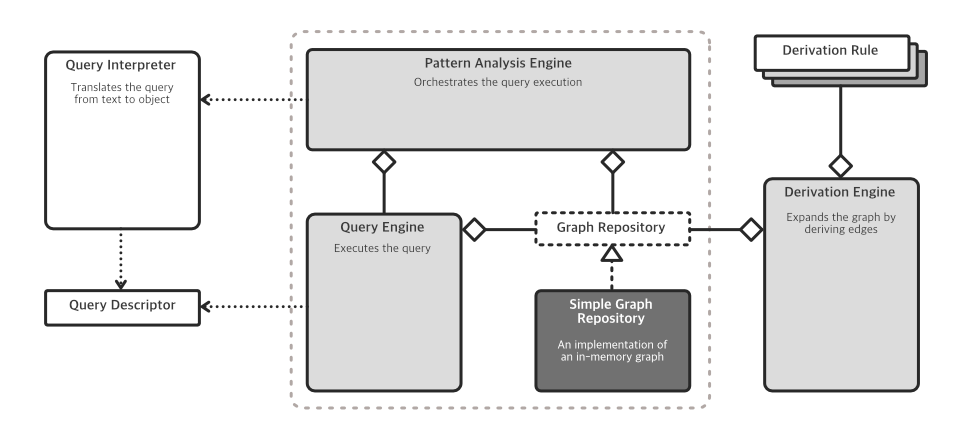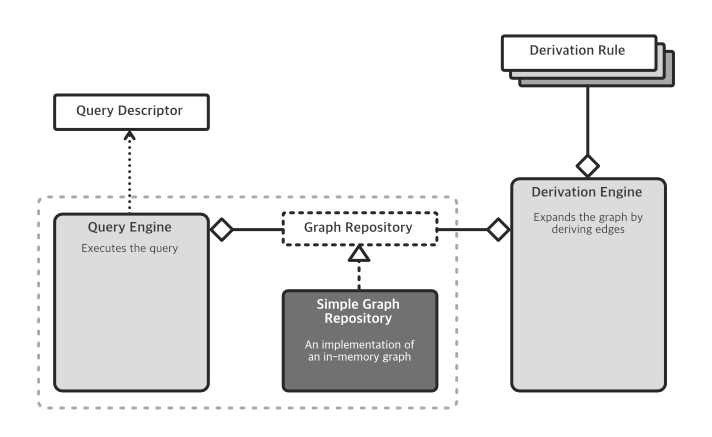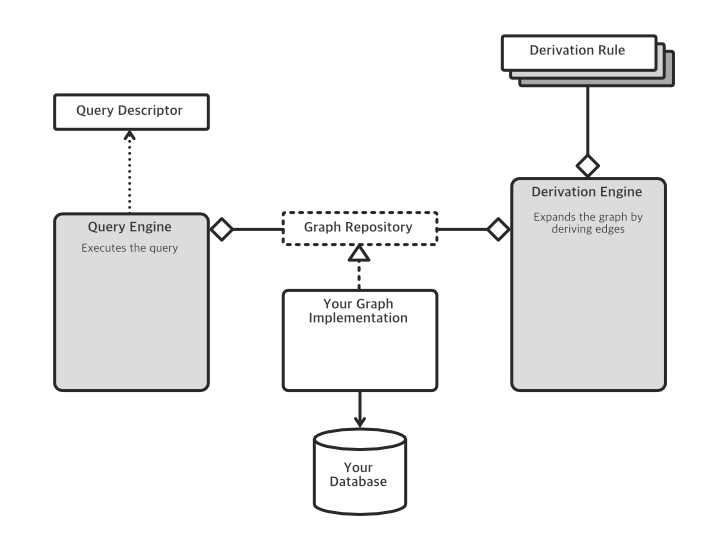@peritoz/pattern-analysis-engine v0.4.1
Pattern Analysis Engine
User-friendly query engine for functional analysis.
About
This lib was created to provide a customizable pattern analysis engine over any repository type (relational, document, graph, key-value or column-oriented). Its purpose is to apply rich pattern-matching logic over a graph containing logical inference edges. It also provides a derivation engine to generate inference edges based on custom rules.
Installation
Using npm:
npm i --save @peritoz/pattern-analysis-engine
Using Yarn:
yarn add @peritoz/pattern-analysis-engine
Getting Started
This lib provides a modular pattern analysis engine composed of:
- User-friendly query language (AMAQL): Graph query language specialized in pattern analysis and designed to be used by non-experts.
- AMAQL Interpreter: AMAQL parser engine that is responsible for translating the query from text to object.
- Query engine: Executes a query defined by a Query Descriptor object.
- Derivation engine: Expands the graph by deriving edges (inference edges) based on custom derivation rules.
- Graph Repository interface specification: Defines the graph repository contract.
- In-memory graph repository: A simple implementation of the graph repository contract.
The Pattern Analysis Engine was designed for partial or full use. Depending on your needs, you can choose not to use AMAQL and provide a query descriptor directly to the Query Engine. Also, you can implement your Graph Repository and connect the engine to your database.
Full Usage Example
The image below describes the Pattern Analysis Engine architecture in full usage.

The graph
The following example shows how to use the in-memory Graph Repository to get started quickly.
import {
SimpleGraphRepository,
SimpleGraphVertex,
SimpleGraphEdge
} from "@peritoz/pattern-analysis-engine";
const graph = new SimpleGraphRepository();
// Adding vertices
// SimpleGraphVertex receives Vertex Name, Types and External Vertex Id
await graph.addVertex(new SimpleGraphVertex("V1", ["t1", "t2"], "1"));
await graph.addVertex(new SimpleGraphVertex("V2", ["t1"], "2"));
// Adding an edge
// SimpleGraphEdge receives Source Id, Target Id, Types and External Edge Id
await graph.addEdge(new SimpleGraphEdge("1", "2", ["et1", "et2"], "E1"));Note: You can specify your own repository by implementing the GraphRepository interface
Derivation Engine
If you want to take advantage of the inference engine, you first need to describe all derivation rules that should be applied to your graph.
A derivation rule is consists of two parts:
- Pattern description: A string describing a relationship pattern to use as a condition for applying the derivation rule. As described in the following example:
(vType1,vType2)[eType1,eType2]>(vType3)<[]()The pattern described above indicates: Matches any relationship chain that starts with a Vertex of type vType1 or vType2, which has outbound relationships (of type eType1 or eType2) to Vertices of type vType3, which, in turn, have inbound relationships (of any type) from vertices of any type.
Note: A Pattern Description is not limited to a two-edge chain. It is also possible to describe more complex patterns formed by more than two edges.
- Derived edge template: The derivation rule effect. It describes the edge output that must be created. An example is shown below.
(3)[eType1](1)The template describes an output edge of type eType1 that has as source the third vertex and as target the first vertex, both from the Pattern Description.
Note: The numbers represent the index (position) of which the element was described in the Pattern Description, starting at 1.
The example below shows how to set up and run a derivation engine.
import {
DerivationRule,
DerivationEngine,
SimpleGraphEdge
} from "@peritoz/pattern-analysis-engine";
const rules = [
new DerivationRule("()[et1]>()[et2,et3]>()", "(1)[et1](3)"),
new DerivationRule("(t1)[et2,et3]>()<[et1](t3)", "(2)[et3](1)"),
new DerivationRule("()<[](t3)[et3]>(t2)", "(3)[et1,et2](1)"),
];
const derivationEngine = new DerivationEngine(graph, rules, (
sourceId: string,
targetId: string,
types: Array<string>,
externalId: string,
derivationPath: Array<string>
) => {
return new SimpleGraphEdge(
sourceId,
targetId,
types,
externalId,
derivationPath
);
});
await derivationEngine.deriveEdges(2);Note: The method deriveEdges receives the number of derivation cycles to be applied over the graph
Monitoring the Derivation Process
You can monitor the derivation process execution by injecting a "logger" instance when instantiating the Derivation Engine. Your logger class should implement the Logger interface:
interface Logger {
info: (message: string) => void;
warn: (message: string) => void;
error: (message: string) => void;
}The example below shows how to inject your Logger implementation when instantiating a Derivation Engine.
import {
DerivationRule,
DerivationEngine,
SimpleGraphEdge
} from "@peritoz/pattern-analysis-engine";
const derivationEngine = new DerivationEngine(graph, rules, (
sourceId: string,
targetId: string,
types: Array<string>,
externalId: string,
derivationPath: Array<string>
) => {
return new SimpleGraphEdge(
sourceId,
targetId,
types,
externalId,
derivationPath
);
},
new YourLogger() // <- Instantiating your Logger implementation
);Creating and using the Pattern Analysis Engine
In order to execute AMAQL queries, you will need to instantiate a PatternAnalysisEngine.
The code snippet below presents a basic usage example.
import {PatternAnalysisEngine} from "@peritoz/pattern-analysis-engine";
const patternAnalysisEngine = new PatternAnalysisEngine(graph);
const result = await patternAnalysisEngine.run('?(t1)->(t2)');The expected result is in the form:
Array<Array<OutputVertex | OutputEdge>>Where:
OutputVertex {
identifier: string;
label: string;
types: Array<string>;
}
OutputEdge {
identifier?: string;
direction: Direction;
types: Array<string>;
derivationPath?: Array<string>;
}Note: The query response will be an array of paths that match the pattern described in the query. Because of this, the path array will always be a chain of VERTEX, (EDGE, VERTEX)+
An example of the expected result is presented below:
[
[
{
"identifier": "1",
"label": "V1",
"types": [
"t1",
"t2"
]
},
{
"direction": 1,
"types": [
"et1"
]
},
{
"identifier": "2",
"label": "V2",
"types": [
"t1"
]
}
]
]Custom Interpreter Example
There are scenarios in which some customizations are needed. For example, AMAQL might not fit your usage well, or you want to execute queries directly from the Query Descriptor object (perhaps to serve a service) without passing an AMAQL query string. In these use cases, you can run queries from a Query Descriptor object using the Query Engine class. This scenario is shown in the image below.

Note: For this use, the graph creation and derivation process remains the same.
Creating a Query Descriptor
A Query Descriptor object describes the entire pattern that should be matched during analysis. It comprises a query chain composed of an array of Query Triple objects. The example below shows how to instantiate a Query Triple and build a Query Descriptor.
import {
QueryNode,
QueryRelationship,
QueryTriple,
Direction,
QueryDescriptor
} from "@peritoz/pattern-analysis-engine";
const leftNode = new QueryNode(
["t1"], // Types
"name", // Search term
[], // Node ids. If not empty, the engine will take as baseline all vertices with the given ids
true // Should be returned. If false, will be ignored when mounting the output
);
const relationship = new QueryRelationship(
["realization"], // Types
Direction.OUTBOUND, // Edge direction
false, // Is negated
false // Is derived. If false, the analysis will not include derived edges
);
const rightNode = new QueryNode(
["t2"],
"another",
[],
true
);
const simplePattern = new QueryTriple(
leftNode,
relationship,
rightNode
);
const queryDescriptor = new QueryDescriptor();
queryDescriptor.addTriple(simplePattern);Querying by Passing a Query Descriptor Object
To run AMAQL queries passing the newly created Query Descriptor object, you will need to instantiate a QueryEngine.
The code snippet below presents a basic usage example.
import {QueryEngine} from "@peritoz/pattern-analysis-engine";
const queryEngine = new QueryEngine(graph);
const result = await queryEngine.run(queryDescriptor);Note: The expected output is the same as that returned by the PatternAnalysisEngine
Minimum Usage Example
If high performance is a strong requirement of your use case, implementing a custom repository is highly recommended. This implementation should implement the GraphRepository contract, abstracting any database of your choice. In addition, it will allow for optimizations tailored to your specific usage scenario.

The AMAQL Query Language
AMAQL is a custom pattern matching language, designed to be easy to use and an advanced tool for pattern analysis.
You can find more details about AMAQL here.